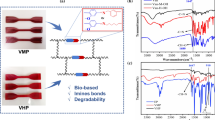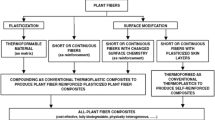Abstract
Poly(ester amide)s have cropped up as an interesting group of polymeric materials entailing excellent mechanical and thermal properties on the ground of typical confinement of ester and amide connectivity in the polymeric chains. Howsoever, extensive usage of polymers derived from conventional petroleum sources is posing a major threat to ecosystem sustainability. In this facet, a bio-based water-soluble poly(ester amide) was synthesized using an environmentally benign route devoid of usage of any solvent. Citric acid, glycerol and hexamethylenediamine were used as the core raw materials for carrying out the synthetic reaction via a polycondensation route. The prepared polymeric resin was characterized using various spectroscopic techniques such as Fourier transform infrared (FTIR), 1H-NMR (Nuclear magnetic resonance), 13C-NMR etc. Poly(vinyl alcohol) was further incorporated to modify the resin. Different compositions of resin/poly(vinyl alcohol) were prepared and used to evaluate their performance. The polymeric films exemplified splendid mechanical attributes namely tensile strength (7–8 MPa), elongation at break (1380–2166%), and toughness (4082–9812 MJm−3) along with satisfactory thermal stability (above 210 °C) and good transparency. Moreover, they possess biodegradability aspects; thereby endowing the characteristics which can overcome the shortcomings of petroleum-derived synthetic poly(ester amide)s and subsequently be utilized in various potential applications, especially as environmentally friendly coating materials.










Similar content being viewed by others
References
Derksen JT, Cuperus FP, Kolster P (1995) Paints and coatings from renewable resources. Ind Crops Prod 3:225–236
Vilela C, Sousa AF, Fonseca AC, Serra AC, Coelho JF, Freire CS, Silvestre AJ (2014) The quest for sustainable polyesters-insights into the future. Polym Chem 5:3119–3141
Hanson MC, Bershteyn A, Crespo MP, Irvine DJ (2014) Antigen delivery by lipid-enveloped PLGA microparticles vaccines mediated by in situ vesicle shedding. Biomacromol 15:2475–2481
Scheirs J, Long TE (2005) Modern polyesters: chemistry and technology of polyesters and copolyesters. Wiley, New York
Pathan S, Ahmad S (2013) s-Triazine ring-modified waterborne alkyd: synthesis, characterization, antibacterial and electrochemical corrosion studies. ACS Sustain Chem Eng 1:1246–1257
Saravari O, Phapant P, Pimpan V (2005) Synthesis of water-reducible acrylic-alkyd resins based on modified palm oil. J Appl Polym Sci 96:1170–1175
Uber R, Sell D, Hirth T (2011) Renewable Raw Materials: New Feedstocks for the Chemical Industry. Wiley, New York
Delidovich I, Hausoul PJ, Deng L, Pfützenreuter R, Rose M, Palkovits R (2016) Alternative monomers based on lignocelluloses and their use for polymer production. Chem Rev 116:1540–1599
Belgacem MN, Gandhi A (2008) Monomers, polymers and composites from renewable reaources. Elsevier, Netherlands
Gandini A (2008) Polymers from renewable resources: a challenge for the future of macromolecular materials. Macromolecules 41:9491–9504
Winnacker M, Rieger B (2016) Poly(ester amide) s: recent insights into synthesis, stability and biomedical applications. Polym Chem 7:7039–7046
Pramanik S, Sagar K, Konwar BK, Karak N (2012) Synthesis, characterization and properties of a castor oil modified biodegradable poly (ester amide) resin. Prog Org Coat 75:569–578
Rodriguez-Galan A, Franco L, Puiggali J (2011) Degradable poly (ester amide) s for biomedical applications. Polymers 3:65–99
Gogoi G, Gogoi S, Karak N (2017) Dimer acid based waterborne hyperbranched poly (ester amide) thermoset as a sustainable coating material. Prog Org Coat 112:57–65
Dutta GK, Karak N (2019) Environmentally benign bio-based waterborne polyesters: Synthesis, thermal and bio-degradation studies. Prog Org Coat 127:419–428
Hazarika D, Karak N (2015) Waterborne sustainable tough hyperbranched aliphatic polyester thermosets. ACS Sustain Chem Eng 3:2458–2468
Wu J, Mutschler MA, Chu CC (2011) Synthesis and characterization of ionic charged water soluble arginine-based poly (ester amide). J Mater Sci Mater Med 22:469–479
Asif A, Shi W (2003) Synthesis and properties of UV curable waterborne hyperbranched aliphatic polyester. Eur Polym J 39:933–938
Mahapatra SS, Karak N (2004) Synthesis and characterization of polyesteramide resins from Nahar seed oil for surface coating applications. Prog Org Coat 51:103–108
Ahmad S, Ashraf SM, Zafar F (2007) Development of linseed oil based polyesteramide without organic solvent at lower temperature. J Appl Polym Sci 104:1143–1148
Ahmad S, Ashraf SM, Naqvi F, Yadav S, Hasnat A (2003) A polyesteramide from Pongamia glabra oil for biologically safe anticorrosive coating. Prog Org Coat 47:95–102
Klonos PA, Kluge M, Robert T, Kyritsis A, Bikiaris DN (2020) Molecular dynamics, crystallization and hydration study of poly(propylene succinate) based poly (ester amide)s. Polymer 186:122056
Papadopoulos L, Klonos PA, Kluge M, Zamboulis A, Terzopoulou Z, Kourtidou D, Magaziotis A, Chrissafis K, Kyritsis A, Bikiaris DN, Robert T (2021) Unlocking the potential of furan-based poly (ester amide) s: an investigation of crystallization, molecular dynamics and degradation kinetics of novel poly (ester amide) s based on renewable poly (propylene furanoate). Polym Chem 12:5518–5534
Kluge M, Papadopoulos L, Magaziotis A, Tzetzis D, Zamboulis A, Bikiaris DN, Robert T (2020) A facile method to synthesize semicrystalline poly(ester amide)s from 2,5-furandicarboxylic acid, 1, 10-decanediol, and crystallizable amido diols. ACS Sustain Chem Eng 8:10812–10821
Papadopoulos L, Kluge M, Bikiaris DN, Robert T (2020) Straightforward synthetic protocol to bio-based unsaturated poly(ester amide)s from itaconic acid with thixotropic behavior. Polymers 12:980
Diaz A, Katsarava R, Puiggali J (2014) Synthesis, properties and applications of biodegradable polymers derived from diols and dicarboxylic acids: From polyesters to poly(ester amide) s. Int J Mol Sci 15:7064–7123
de Jongh PA, Paul PK, Khoshdel E, Wilson P, Kempe K, Haddleton DM (2017) High Tg poly (ester amide) s by melt polycondensation of monomers from renewable resources; citric acid, D-glucono-δ-lactone and amino acids: A DSC study. Eur Polym J 94:11–19
Patil AM (2018) Synthesis and characterization of bio-based polyester and polyamide from citric acid and mannitol. Orient J Chem 34:538
Gyawali D, Nair P, Zhang Y, Tran RT, Zhang C, Samchukov M, Makarov M, Kim HK, Yang J (2010) Citric acid-derived in situ crosslinkable biodegradable polymers for cell delivery. Biomaterials 31:9092–9105
Mukherji SM, Singh SP, Kapoor RP (1985) Organic Chemistry. Wiley, New York
Sonker AK, Verma V (2018) Influence of crosslinking methods towards poly (vinyl alcohol) properties: Microwave irradiation and conventional heating. J Appl Polym Sci 135:46125
Etherington KJ, Rodger A, Hemming P (2001) CHN microanalysis-A technique for the 21st century? Lab Plus Int 26:1–2
Suganthi S, Vignesh S, Sundar JK, Raj V (2020) Fabrication of PVA polymer films with improved antibacterial activity by fine-tuning via organic acids for food packaging applications. Appl Water Sci 10:1–11
Gogoi S, Karak N (2014) Biobased biodegradable waterborne hyperbranched polyurethane as an ecofriendly sustainable material. ACS Sustain Chem Eng 2:2730–2738
Fong RJ, Robertson A, Mallon PE, Thompson RL (2018) The impact of plasticizer and degree of hydrolysis on free volume of poly (vinyl alcohol) films. Polymers 10:1036
Khoirunnisa AR, Joni IM, Panatarani C, Rochima E, Praseptiangga D (2018) UV-screening, transparency and water barrier properties of semi refined iota carrageenan packaging film incorporated with ZnO nanoparticles. AIP Conference Proceedings. AIP Publishing LLC, United States
Pramanik S, Konwarh R, Sagar K, Konwarh BK, Karak N (2013) Bio-degradable vegetable oil based hyperbranched poly (ester amide) as an advanced surface coating material. Prog Org Coat 76:689–697
Rydz J, Sikorska W, Kyulavska M, Christova D (2015) Polyester-based (bio) degradable polymers as environmentally friendly materials for sustainable development. Int J Mol Sci 16:564–596
Dros AB, Larue O, Reimond A, De Campo F, Pera-Titus M (2015) Hexamethylenediamine (HMDA) from fossil-vs. bio-based routes: an economic and life cycle assessment comparative study. Green Chem 17:4760–4772
Liu P, Chen W, Liu C, Tian M, Liu P (2019) A novel poly (vinyl alcohol)/poly (ethylene glycol) scaffold for tissue engineering with a unique bimodal open-celled structure fabricated using supercritical fluid foaming. Sci Rep 9:1–2
Acknowledgements
The authors express their profound gratitude to Sophisticated Analytical Instrumentation Centre (SAIC), Tezpur University and Central Instrumentation Facility (CIF), IITG for helping in carrying out all instrumentation analyses.
Author information
Authors and Affiliations
Corresponding author
Ethics declarations
Conflict of interests
The authors have no relevant financial or non-financial interests to disclose.
Additional information
Publisher's Note
Springer Nature remains neutral with regard to jurisdictional claims in published maps and institutional affiliations.
Rights and permissions
Springer Nature or its licensor holds exclusive rights to this article under a publishing agreement with the author(s) or other rightsholder(s); author self-archiving of the accepted manuscript version of this article is solely governed by the terms of such publishing agreement and applicable law.
About this article
Cite this article
Kar, A., Karak, N. Bio-based poly(ester amide): mechanical, thermal and biodegradable behaviors. J Polym Res 29, 366 (2022). https://doi.org/10.1007/s10965-022-03214-z
Received:
Accepted:
Published:
DOI: https://doi.org/10.1007/s10965-022-03214-z




